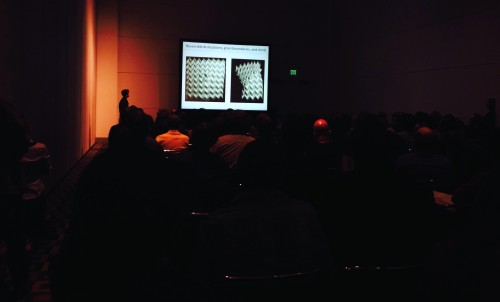
A rapt audience watches Silverberg’s presentation on origami.
By Tushna Commissariat at the APS March Meeting in Denver
Origami – the traditional Japanese art of paper folding – has long intrigued mathematicians and physicists alike. In addition to understanding the mechanics of it, its principles have been applied to the folding of DNA and other nanoscale structural designing, as well as in the folding of rigid sheets using hinges. Indeed, the latter is used for a variety of purposes: from the simple folds of a paper bag with a flat bottom to the folding of airbags and telescopes, and even to simulating the folding of large solar panels for space satellites (known as the Miura fold, named after its inventor the Japanese astrophysicist Koryo Miura).
This morning, I went along to an APS session that looked at “extreme mechanics”, where researchers were talking about the origami and kirigami – a version of origami that involves folding and making small cuts to a single sheet of paper – of structural metamaterials.
Jesse Silverberg of Cornell University (the more avid of readers may recognize Silverberg’s name from his work on mosh-pits and collective behaviour) was talking about the mechanical properties of “origami-inspired materials”. Such materials, according to Silverberg, could be the ultimate next-generation materials that are responsive and tunable. He also looks at what would happen if deliberate faults or defects were introduced into such folds, because “defects are known to dramatically alter the bulk properties in other periodic materials, [so] we introduce defects into the folding pattern to investigate their effects on the macroscopic mechanical properties”. Interestingly, the researchers found that a single defect increases the overall stiffness of a material, but this could also be mitigated by the introduction of a second defect in the opposite direction, as this serves to cancel out the first and the material goes back to its original state.
Also speaking at the session was Pablo Damasenco of the University of Michigan. He talked about the simulations and experiments carried out by his group that tuned the mechanical properties of nanocomposite sheets via “secondary structures” patterning – or using the art of kirigami. As Damasenco’s abstract rather eloquently says “ despite the small set of building blocks used for their assembly, naturally occurring materials such as proteins show remarkable diversity in their mechanical properties, ranging from something resembling rubber – low stiffness, high resilience and extensibility – to silk – high stiffness and strength” and this was his inspiration.
His simulations reveal the main cutting features that would be necessary to obtain a desired material extensibility. He also found that cuts can induce elastic behaviour in otherwise stiff materials, that the tunable properties are scalable from the micro to the macro and that the method could allow researchers “reversible access” to 3D structures from 2D materials.
There was also a later session where other researchers showed how they have crafted 3D grapheme structures and devices using kirigami, but I didn’t have the time to attend that. Suffice to say that origami is on the APS radar – so get folding.
Guidelines
Show/hide formatting guidelines
this text was deletedwhere people live in harmony with nature and animals</q>
Some text